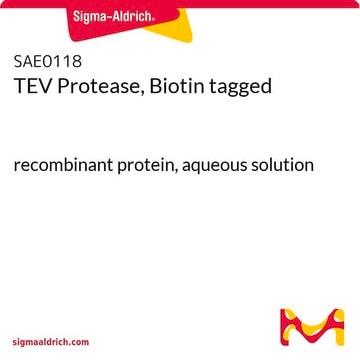Kluczowe dokumenty
SAE0110
HRV-3C Protease, Biotin tagged
Recombinant protein, 0.8-1.2 mg/mL, aqueous solution
Synonim(y):
Human Rhinovirus 3C Protease, Levlfqgp site protease, PreScission Protease
Wybierz wielkość
986,00 zł
Wybierz wielkość
About This Item
986,00 zł
Polecane produkty
pochodzenie biologiczne
human (human Rhinovirus Type 14)
rekombinowane
expressed in E. coli
Próba
≥90%
Formularz
aqueous solution
aktywność właściwa
≥5000 U/mg
masa cząsteczkowa
22 kDa
stężenie
0.8-1.2 mg/mL
metody
protein purification: suitable
przydatność
suitable for protein modification
Zastosowanie
life science and biopharma
Warunki transportu
dry ice
temp. przechowywania
−20°C
Opis ogólny
This biotinylated HRV-3C protease is intended for on-column cleavage of fusion proteins with an HRV-3C cleavage site. It specifically cleaves the protein of interest from a column-bound fusion protein, leaving the fusion domain or tag bound to the affinity column (e.g. Ni-NTA column) and eluting only the protein of interest. This method is advantageous over post-elution cleavage for several reasons:
- It eliminates most impurities normally associated with purification on Ni-chelating columns.
- It allows gentler elution conditions, with added flexibility in the elution buffer composition. This can mitigate protein aggregation and inactivation.
After cleavage, the protease can be removed with any avidin-conjugated or streptavidin-conjugated beads. This product has been enzymatically biotinylated with no effect on its proteolytic activity. It has no additional protein purification tags. The product is supplied in aqueous buffer (0.8–1.2 mg/mL) with 20 mM Trizma®-HCl, pH 8.0, 200 mM NaCl, 1 mM TCEP, and 50% (v/v) glycerol.
Uwaga dotycząca przygotowania
Informacje prawne
Kod klasy składowania
10 - Combustible liquids
Klasa zagrożenia wodnego (WGK)
WGK 2
Temperatura zapłonu (°F)
Not applicable
Temperatura zapłonu (°C)
Not applicable
Wybierz jedną z najnowszych wersji:
Certyfikaty analizy (CoA)
Nie widzisz odpowiedniej wersji?
Jeśli potrzebujesz konkretnej wersji, możesz wyszukać konkretny certyfikat według numeru partii lub serii.
Masz już ten produkt?
Dokumenty związane z niedawno zakupionymi produktami zostały zamieszczone w Bibliotece dokumentów.
Produkty
Proteases for biotinylated tag removal for protein purification workflows with related reagents and technical resources.
Active Filters
Nasz zespół naukowców ma doświadczenie we wszystkich obszarach badań, w tym w naukach przyrodniczych, materiałoznawstwie, syntezie chemicznej, chromatografii, analityce i wielu innych dziedzinach.
Skontaktuj się z zespołem ds. pomocy technicznej








